Corporate Accounting: Analyzing Cash Flow & Deferred Tax at Woolworths
VerifiedAdded on 2023/06/11
|12
|2632
|187
Report
AI Summary
This report provides an analysis of Woolworths' corporate accounting practices, focusing on its cash flow statement and deferred tax assets and liabilities. The analysis covers the financial years 2015, 2016, and 2017, examining operating, investing, and financing activities. It discusses the reporting of items in the other comprehensive income statement, the separation of these items from the profit and loss statement, and the reasons for differences in tax expenses. The report also explains deferred tax assets/liabilities and differences between income tax payable and current income tax expense, as well as between current income tax expense and income tax paid. The report concludes by highlighting the complexity of Woolworths' annual report and its compliance with AASB 112.
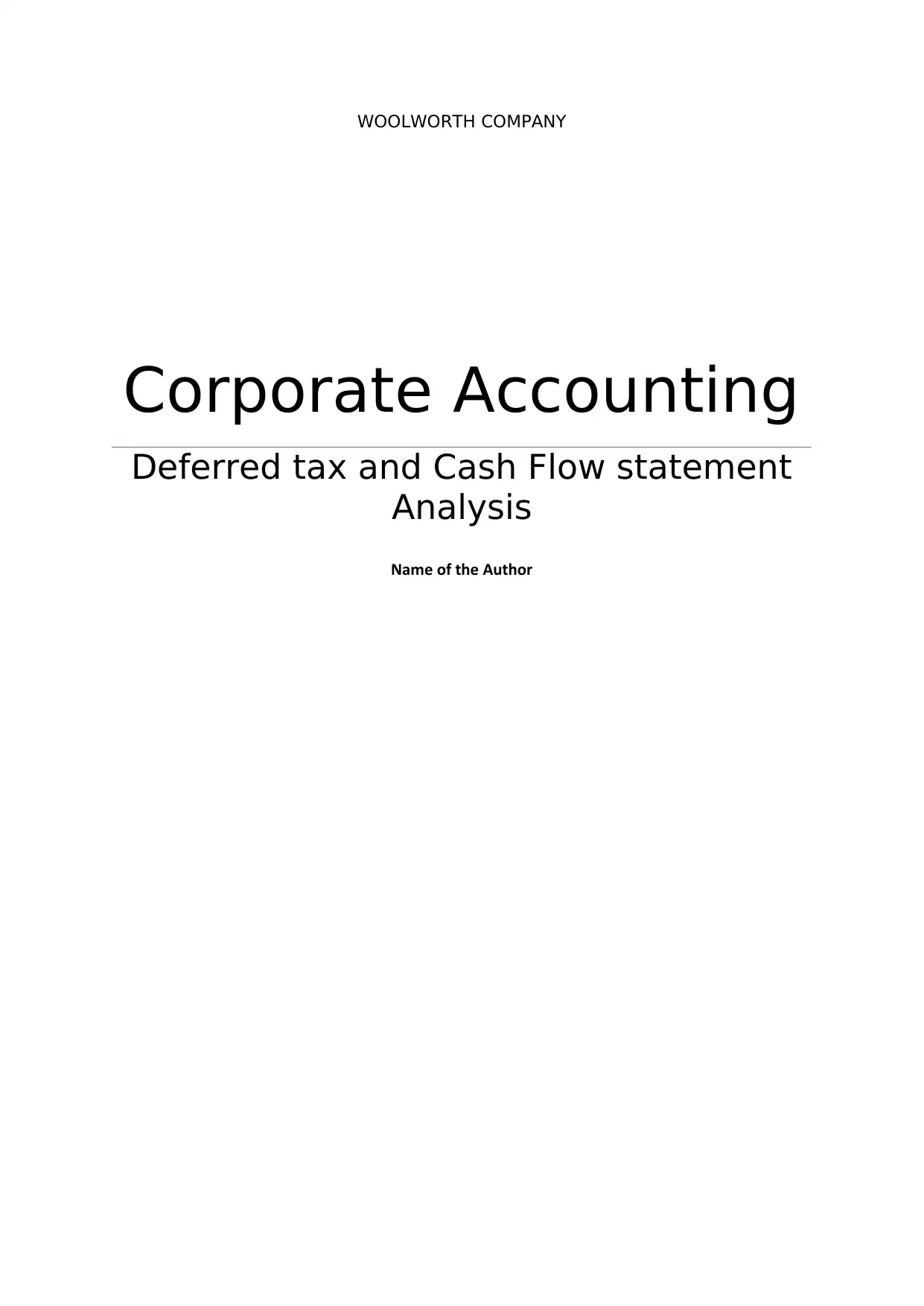
WOOLWORTH COMPANY
Corporate Accounting
Deferred tax and Cash Flow statement
Analysis
Name of the Author
Corporate Accounting
Deferred tax and Cash Flow statement
Analysis
Name of the Author
Paraphrase This Document
Need a fresh take? Get an instant paraphrase of this document with our AI Paraphraser
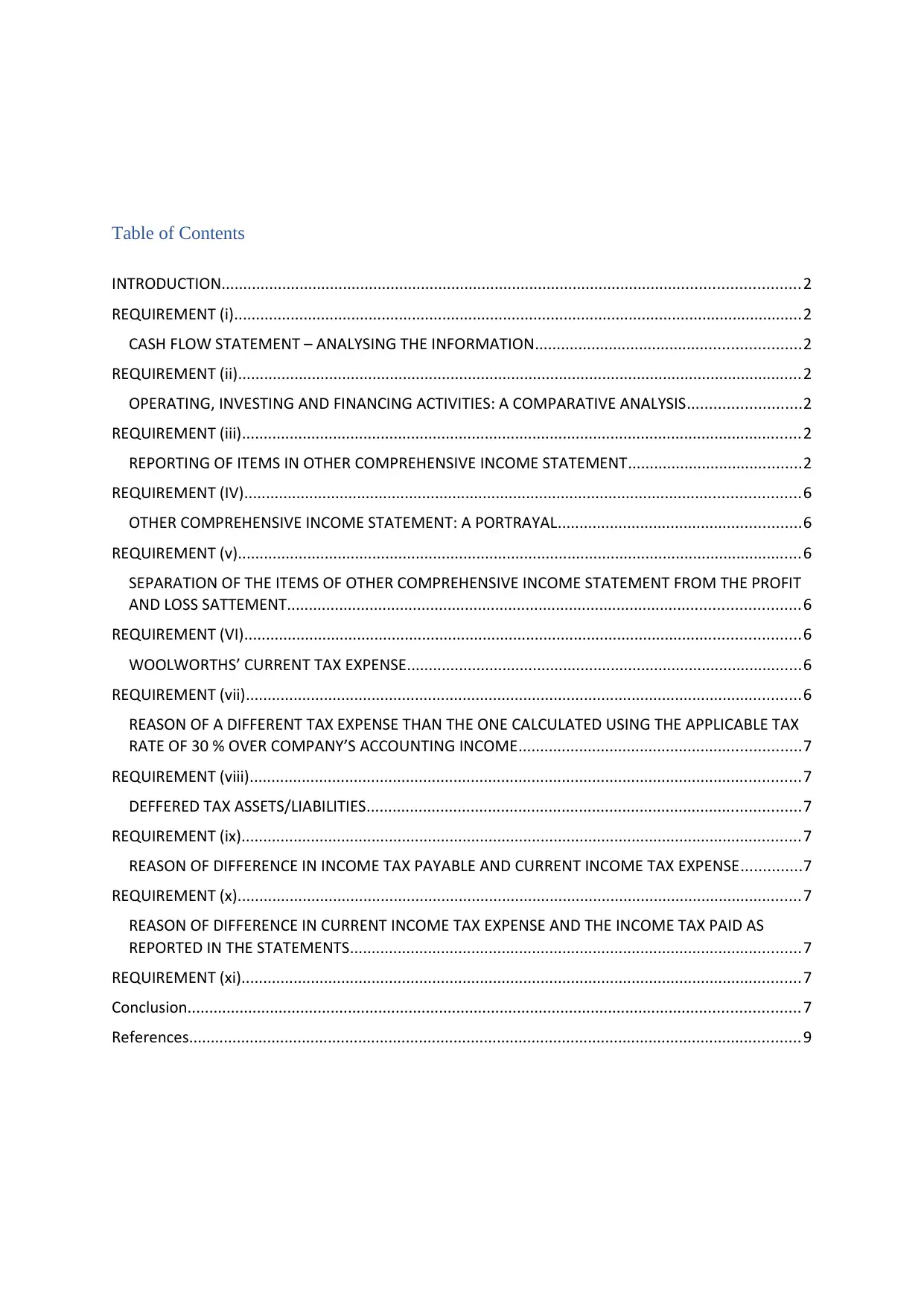
Table of Contents
INTRODUCTION.....................................................................................................................................2
REQUIREMENT (i)...................................................................................................................................2
CASH FLOW STATEMENT – ANALYSING THE INFORMATION.............................................................2
REQUIREMENT (ii)..................................................................................................................................2
OPERATING, INVESTING AND FINANCING ACTIVITIES: A COMPARATIVE ANALYSIS..........................2
REQUIREMENT (iii).................................................................................................................................2
REPORTING OF ITEMS IN OTHER COMPREHENSIVE INCOME STATEMENT........................................2
REQUIREMENT (IV)................................................................................................................................6
OTHER COMPREHENSIVE INCOME STATEMENT: A PORTRAYAL........................................................6
REQUIREMENT (v)..................................................................................................................................6
SEPARATION OF THE ITEMS OF OTHER COMPREHENSIVE INCOME STATEMENT FROM THE PROFIT
AND LOSS SATTEMENT......................................................................................................................6
REQUIREMENT (VI)................................................................................................................................6
WOOLWORTHS’ CURRENT TAX EXPENSE...........................................................................................6
REQUIREMENT (vii)................................................................................................................................6
REASON OF A DIFFERENT TAX EXPENSE THAN THE ONE CALCULATED USING THE APPLICABLE TAX
RATE OF 30 % OVER COMPANY’S ACCOUNTING INCOME.................................................................7
REQUIREMENT (viii)...............................................................................................................................7
DEFFERED TAX ASSETS/LIABILITIES....................................................................................................7
REQUIREMENT (ix).................................................................................................................................7
REASON OF DIFFERENCE IN INCOME TAX PAYABLE AND CURRENT INCOME TAX EXPENSE..............7
REQUIREMENT (x)..................................................................................................................................7
REASON OF DIFFERENCE IN CURRENT INCOME TAX EXPENSE AND THE INCOME TAX PAID AS
REPORTED IN THE STATEMENTS........................................................................................................7
REQUIREMENT (xi).................................................................................................................................7
Conclusion.............................................................................................................................................7
References.............................................................................................................................................9
INTRODUCTION.....................................................................................................................................2
REQUIREMENT (i)...................................................................................................................................2
CASH FLOW STATEMENT – ANALYSING THE INFORMATION.............................................................2
REQUIREMENT (ii)..................................................................................................................................2
OPERATING, INVESTING AND FINANCING ACTIVITIES: A COMPARATIVE ANALYSIS..........................2
REQUIREMENT (iii).................................................................................................................................2
REPORTING OF ITEMS IN OTHER COMPREHENSIVE INCOME STATEMENT........................................2
REQUIREMENT (IV)................................................................................................................................6
OTHER COMPREHENSIVE INCOME STATEMENT: A PORTRAYAL........................................................6
REQUIREMENT (v)..................................................................................................................................6
SEPARATION OF THE ITEMS OF OTHER COMPREHENSIVE INCOME STATEMENT FROM THE PROFIT
AND LOSS SATTEMENT......................................................................................................................6
REQUIREMENT (VI)................................................................................................................................6
WOOLWORTHS’ CURRENT TAX EXPENSE...........................................................................................6
REQUIREMENT (vii)................................................................................................................................6
REASON OF A DIFFERENT TAX EXPENSE THAN THE ONE CALCULATED USING THE APPLICABLE TAX
RATE OF 30 % OVER COMPANY’S ACCOUNTING INCOME.................................................................7
REQUIREMENT (viii)...............................................................................................................................7
DEFFERED TAX ASSETS/LIABILITIES....................................................................................................7
REQUIREMENT (ix).................................................................................................................................7
REASON OF DIFFERENCE IN INCOME TAX PAYABLE AND CURRENT INCOME TAX EXPENSE..............7
REQUIREMENT (x)..................................................................................................................................7
REASON OF DIFFERENCE IN CURRENT INCOME TAX EXPENSE AND THE INCOME TAX PAID AS
REPORTED IN THE STATEMENTS........................................................................................................7
REQUIREMENT (xi).................................................................................................................................7
Conclusion.............................................................................................................................................7
References.............................................................................................................................................9
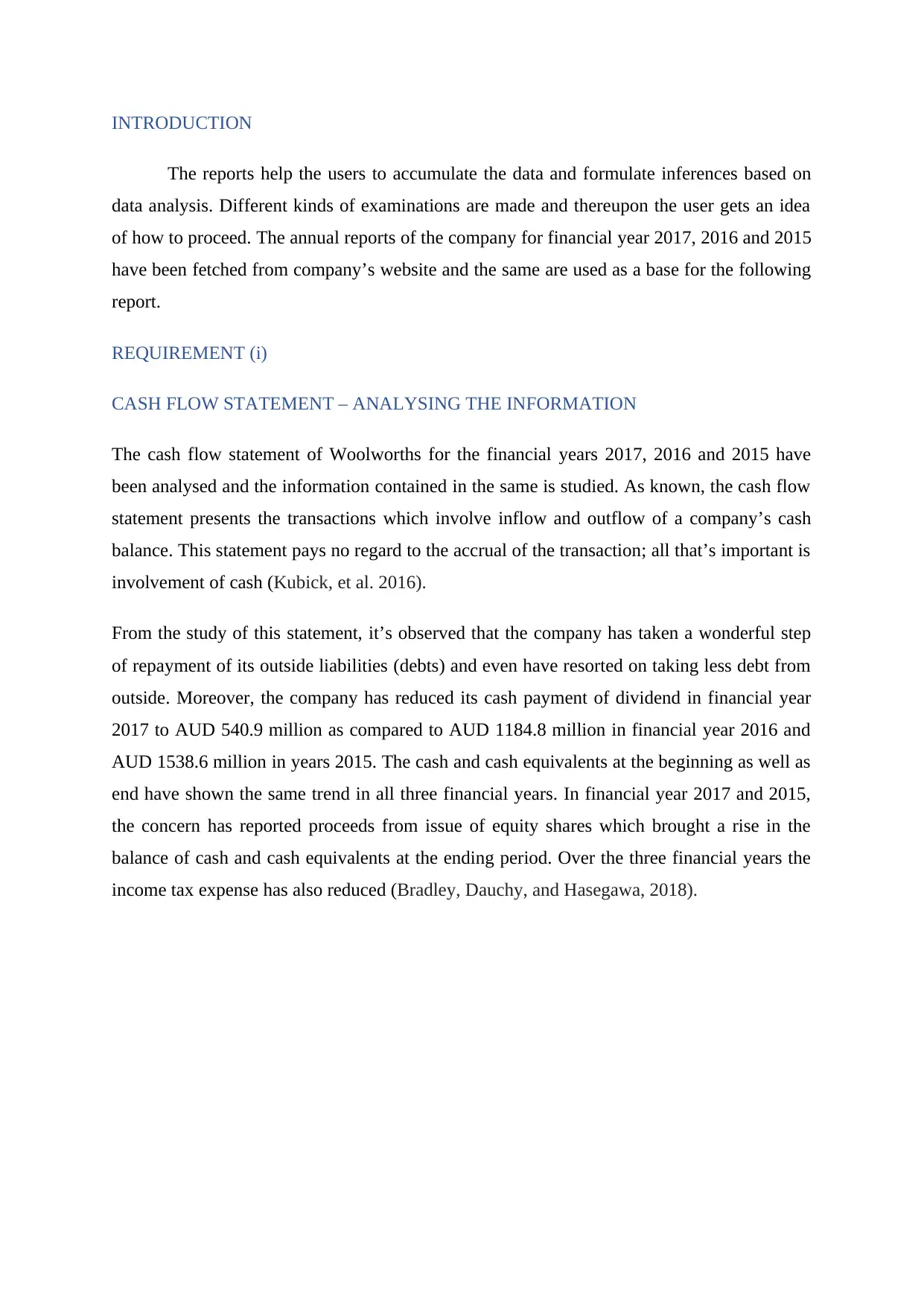
INTRODUCTION
The reports help the users to accumulate the data and formulate inferences based on
data analysis. Different kinds of examinations are made and thereupon the user gets an idea
of how to proceed. The annual reports of the company for financial year 2017, 2016 and 2015
have been fetched from company’s website and the same are used as a base for the following
report.
REQUIREMENT (i)
CASH FLOW STATEMENT – ANALYSING THE INFORMATION
The cash flow statement of Woolworths for the financial years 2017, 2016 and 2015 have
been analysed and the information contained in the same is studied. As known, the cash flow
statement presents the transactions which involve inflow and outflow of a company’s cash
balance. This statement pays no regard to the accrual of the transaction; all that’s important is
involvement of cash (Kubick, et al. 2016).
From the study of this statement, it’s observed that the company has taken a wonderful step
of repayment of its outside liabilities (debts) and even have resorted on taking less debt from
outside. Moreover, the company has reduced its cash payment of dividend in financial year
2017 to AUD 540.9 million as compared to AUD 1184.8 million in financial year 2016 and
AUD 1538.6 million in years 2015. The cash and cash equivalents at the beginning as well as
end have shown the same trend in all three financial years. In financial year 2017 and 2015,
the concern has reported proceeds from issue of equity shares which brought a rise in the
balance of cash and cash equivalents at the ending period. Over the three financial years the
income tax expense has also reduced (Bradley, Dauchy, and Hasegawa, 2018).
The reports help the users to accumulate the data and formulate inferences based on
data analysis. Different kinds of examinations are made and thereupon the user gets an idea
of how to proceed. The annual reports of the company for financial year 2017, 2016 and 2015
have been fetched from company’s website and the same are used as a base for the following
report.
REQUIREMENT (i)
CASH FLOW STATEMENT – ANALYSING THE INFORMATION
The cash flow statement of Woolworths for the financial years 2017, 2016 and 2015 have
been analysed and the information contained in the same is studied. As known, the cash flow
statement presents the transactions which involve inflow and outflow of a company’s cash
balance. This statement pays no regard to the accrual of the transaction; all that’s important is
involvement of cash (Kubick, et al. 2016).
From the study of this statement, it’s observed that the company has taken a wonderful step
of repayment of its outside liabilities (debts) and even have resorted on taking less debt from
outside. Moreover, the company has reduced its cash payment of dividend in financial year
2017 to AUD 540.9 million as compared to AUD 1184.8 million in financial year 2016 and
AUD 1538.6 million in years 2015. The cash and cash equivalents at the beginning as well as
end have shown the same trend in all three financial years. In financial year 2017 and 2015,
the concern has reported proceeds from issue of equity shares which brought a rise in the
balance of cash and cash equivalents at the ending period. Over the three financial years the
income tax expense has also reduced (Bradley, Dauchy, and Hasegawa, 2018).
⊘ This is a preview!⊘
Do you want full access?
Subscribe today to unlock all pages.

Trusted by 1+ million students worldwide
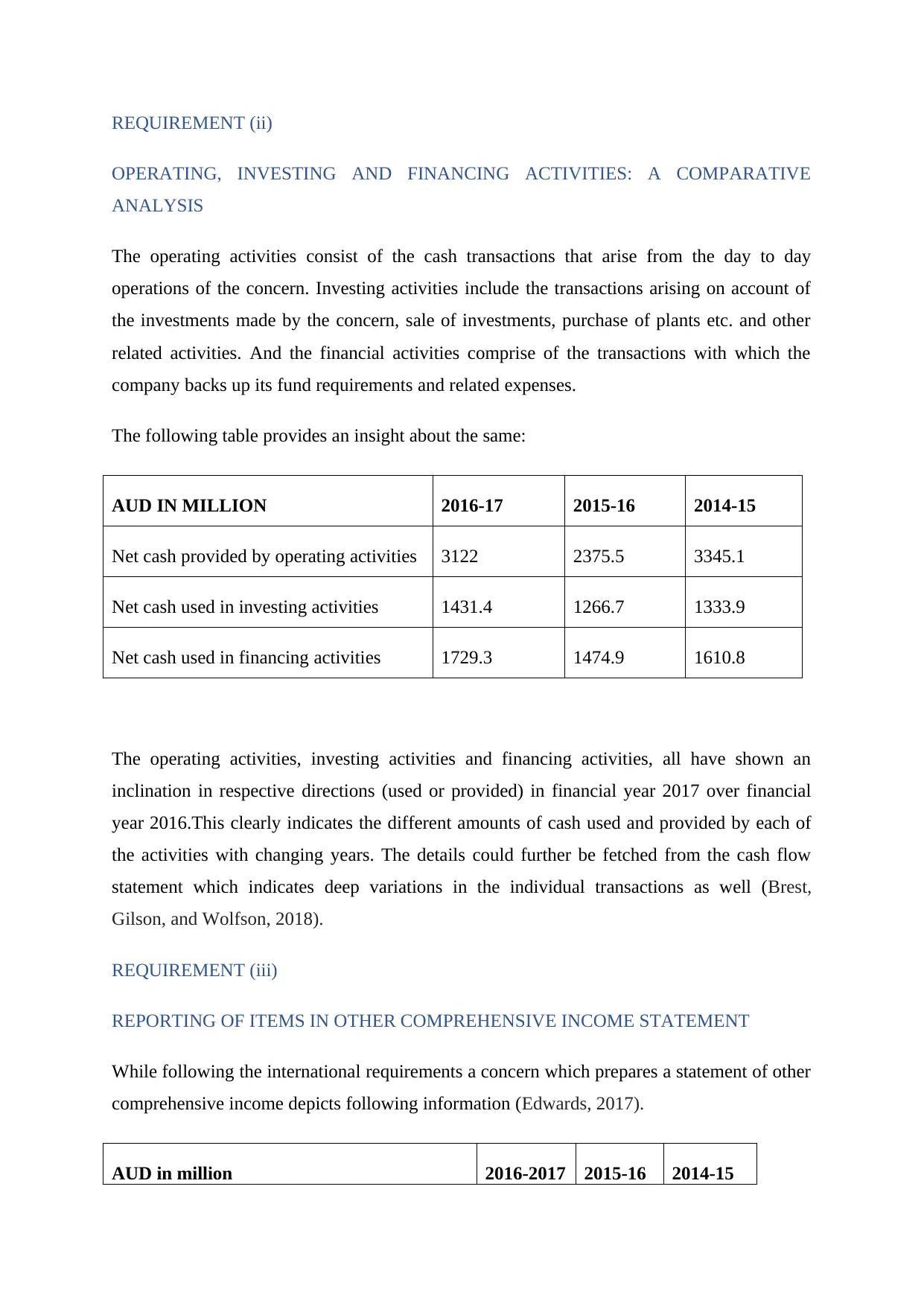
REQUIREMENT (ii)
OPERATING, INVESTING AND FINANCING ACTIVITIES: A COMPARATIVE
ANALYSIS
The operating activities consist of the cash transactions that arise from the day to day
operations of the concern. Investing activities include the transactions arising on account of
the investments made by the concern, sale of investments, purchase of plants etc. and other
related activities. And the financial activities comprise of the transactions with which the
company backs up its fund requirements and related expenses.
The following table provides an insight about the same:
AUD IN MILLION 2016-17 2015-16 2014-15
Net cash provided by operating activities 3122 2375.5 3345.1
Net cash used in investing activities 1431.4 1266.7 1333.9
Net cash used in financing activities 1729.3 1474.9 1610.8
The operating activities, investing activities and financing activities, all have shown an
inclination in respective directions (used or provided) in financial year 2017 over financial
year 2016.This clearly indicates the different amounts of cash used and provided by each of
the activities with changing years. The details could further be fetched from the cash flow
statement which indicates deep variations in the individual transactions as well (Brest,
Gilson, and Wolfson, 2018).
REQUIREMENT (iii)
REPORTING OF ITEMS IN OTHER COMPREHENSIVE INCOME STATEMENT
While following the international requirements a concern which prepares a statement of other
comprehensive income depicts following information (Edwards, 2017).
AUD in million 2016-2017 2015-16 2014-15
OPERATING, INVESTING AND FINANCING ACTIVITIES: A COMPARATIVE
ANALYSIS
The operating activities consist of the cash transactions that arise from the day to day
operations of the concern. Investing activities include the transactions arising on account of
the investments made by the concern, sale of investments, purchase of plants etc. and other
related activities. And the financial activities comprise of the transactions with which the
company backs up its fund requirements and related expenses.
The following table provides an insight about the same:
AUD IN MILLION 2016-17 2015-16 2014-15
Net cash provided by operating activities 3122 2375.5 3345.1
Net cash used in investing activities 1431.4 1266.7 1333.9
Net cash used in financing activities 1729.3 1474.9 1610.8
The operating activities, investing activities and financing activities, all have shown an
inclination in respective directions (used or provided) in financial year 2017 over financial
year 2016.This clearly indicates the different amounts of cash used and provided by each of
the activities with changing years. The details could further be fetched from the cash flow
statement which indicates deep variations in the individual transactions as well (Brest,
Gilson, and Wolfson, 2018).
REQUIREMENT (iii)
REPORTING OF ITEMS IN OTHER COMPREHENSIVE INCOME STATEMENT
While following the international requirements a concern which prepares a statement of other
comprehensive income depicts following information (Edwards, 2017).
AUD in million 2016-2017 2015-16 2014-15
Paraphrase This Document
Need a fresh take? Get an instant paraphrase of this document with our AI Paraphraser

Profit/(Loss) for the period 1,593.4 (2,347.9) 2,137.4
Other comprehensive income
Items that may be reclassified to profit or loss
(net of tax)
(2.1) 179 (70.7)
Items that will not be reclassified to profit or
loss (net of tax)
4.4 9.6 15
Other comprehensive income (net of tax) 2.3 188.6 (55.7)
Total comprehensive income from continuing
operations
1,480.0 955.4 2244.2
Total comprehensive income/(loss) from
discontinued operations
115.7 (3,114.7) (162.5)
Total comprehensive income/(loss) for the
period
1,595.7 (2,159.3) 2081.7
Total comprehensive income/(loss) attributable
to:
Equity holders of the parent entity 1,535.8 (1,046.2) 2,090.1
Non-controlling interests 59.9 (1,113.1) (8.4)
TOTAL 1,595.7 (2,159.3) (2,159.3)
Other comprehensive income
Items that may be reclassified to profit or loss
(net of tax)
(2.1) 179 (70.7)
Items that will not be reclassified to profit or
loss (net of tax)
4.4 9.6 15
Other comprehensive income (net of tax) 2.3 188.6 (55.7)
Total comprehensive income from continuing
operations
1,480.0 955.4 2244.2
Total comprehensive income/(loss) from
discontinued operations
115.7 (3,114.7) (162.5)
Total comprehensive income/(loss) for the
period
1,595.7 (2,159.3) 2081.7
Total comprehensive income/(loss) attributable
to:
Equity holders of the parent entity 1,535.8 (1,046.2) 2,090.1
Non-controlling interests 59.9 (1,113.1) (8.4)
TOTAL 1,595.7 (2,159.3) (2,159.3)
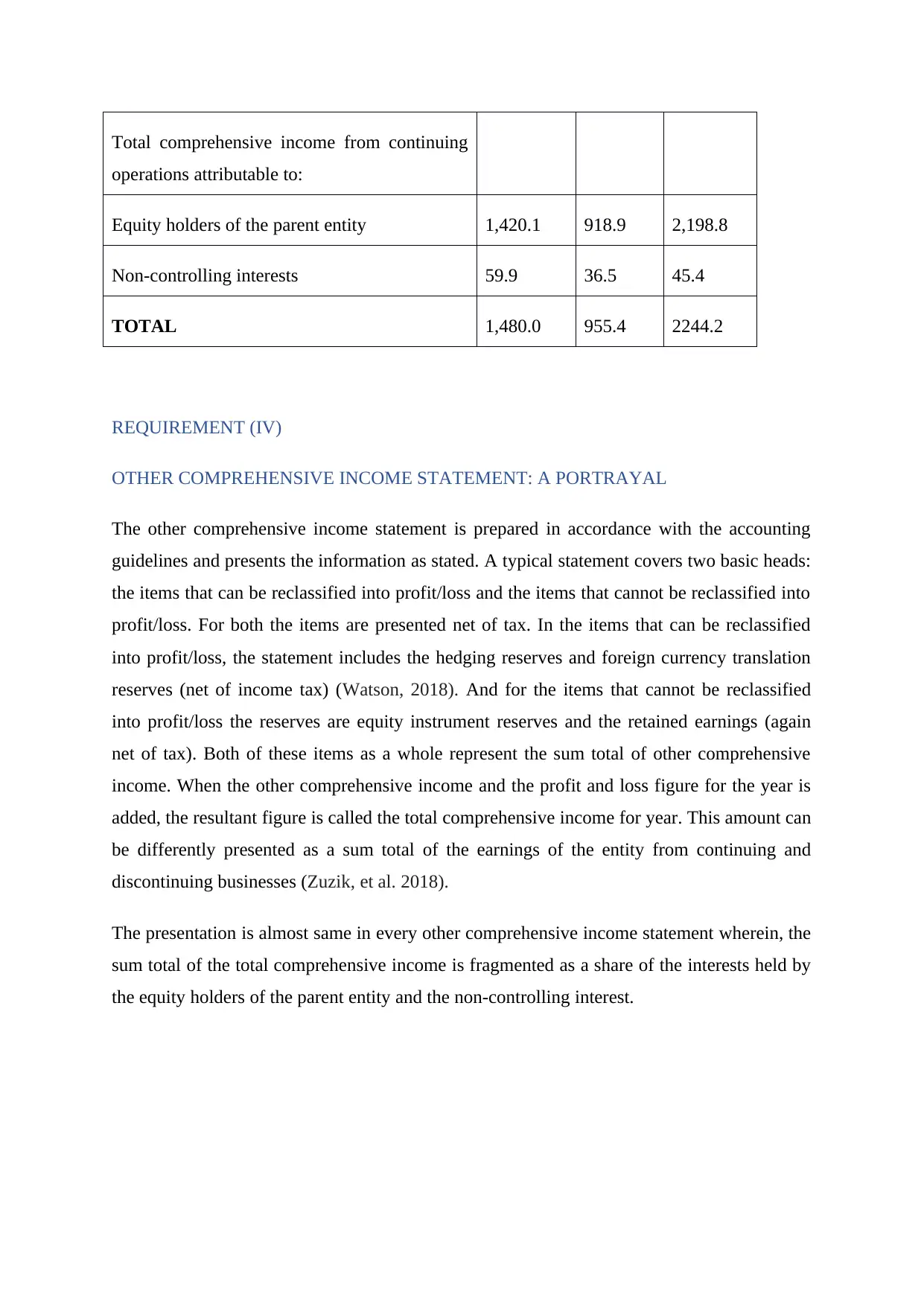
Total comprehensive income from continuing
operations attributable to:
Equity holders of the parent entity 1,420.1 918.9 2,198.8
Non-controlling interests 59.9 36.5 45.4
TOTAL 1,480.0 955.4 2244.2
REQUIREMENT (IV)
OTHER COMPREHENSIVE INCOME STATEMENT: A PORTRAYAL
The other comprehensive income statement is prepared in accordance with the accounting
guidelines and presents the information as stated. A typical statement covers two basic heads:
the items that can be reclassified into profit/loss and the items that cannot be reclassified into
profit/loss. For both the items are presented net of tax. In the items that can be reclassified
into profit/loss, the statement includes the hedging reserves and foreign currency translation
reserves (net of income tax) (Watson, 2018). And for the items that cannot be reclassified
into profit/loss the reserves are equity instrument reserves and the retained earnings (again
net of tax). Both of these items as a whole represent the sum total of other comprehensive
income. When the other comprehensive income and the profit and loss figure for the year is
added, the resultant figure is called the total comprehensive income for year. This amount can
be differently presented as a sum total of the earnings of the entity from continuing and
discontinuing businesses (Zuzik, et al. 2018).
The presentation is almost same in every other comprehensive income statement wherein, the
sum total of the total comprehensive income is fragmented as a share of the interests held by
the equity holders of the parent entity and the non-controlling interest.
operations attributable to:
Equity holders of the parent entity 1,420.1 918.9 2,198.8
Non-controlling interests 59.9 36.5 45.4
TOTAL 1,480.0 955.4 2244.2
REQUIREMENT (IV)
OTHER COMPREHENSIVE INCOME STATEMENT: A PORTRAYAL
The other comprehensive income statement is prepared in accordance with the accounting
guidelines and presents the information as stated. A typical statement covers two basic heads:
the items that can be reclassified into profit/loss and the items that cannot be reclassified into
profit/loss. For both the items are presented net of tax. In the items that can be reclassified
into profit/loss, the statement includes the hedging reserves and foreign currency translation
reserves (net of income tax) (Watson, 2018). And for the items that cannot be reclassified
into profit/loss the reserves are equity instrument reserves and the retained earnings (again
net of tax). Both of these items as a whole represent the sum total of other comprehensive
income. When the other comprehensive income and the profit and loss figure for the year is
added, the resultant figure is called the total comprehensive income for year. This amount can
be differently presented as a sum total of the earnings of the entity from continuing and
discontinuing businesses (Zuzik, et al. 2018).
The presentation is almost same in every other comprehensive income statement wherein, the
sum total of the total comprehensive income is fragmented as a share of the interests held by
the equity holders of the parent entity and the non-controlling interest.
⊘ This is a preview!⊘
Do you want full access?
Subscribe today to unlock all pages.

Trusted by 1+ million students worldwide
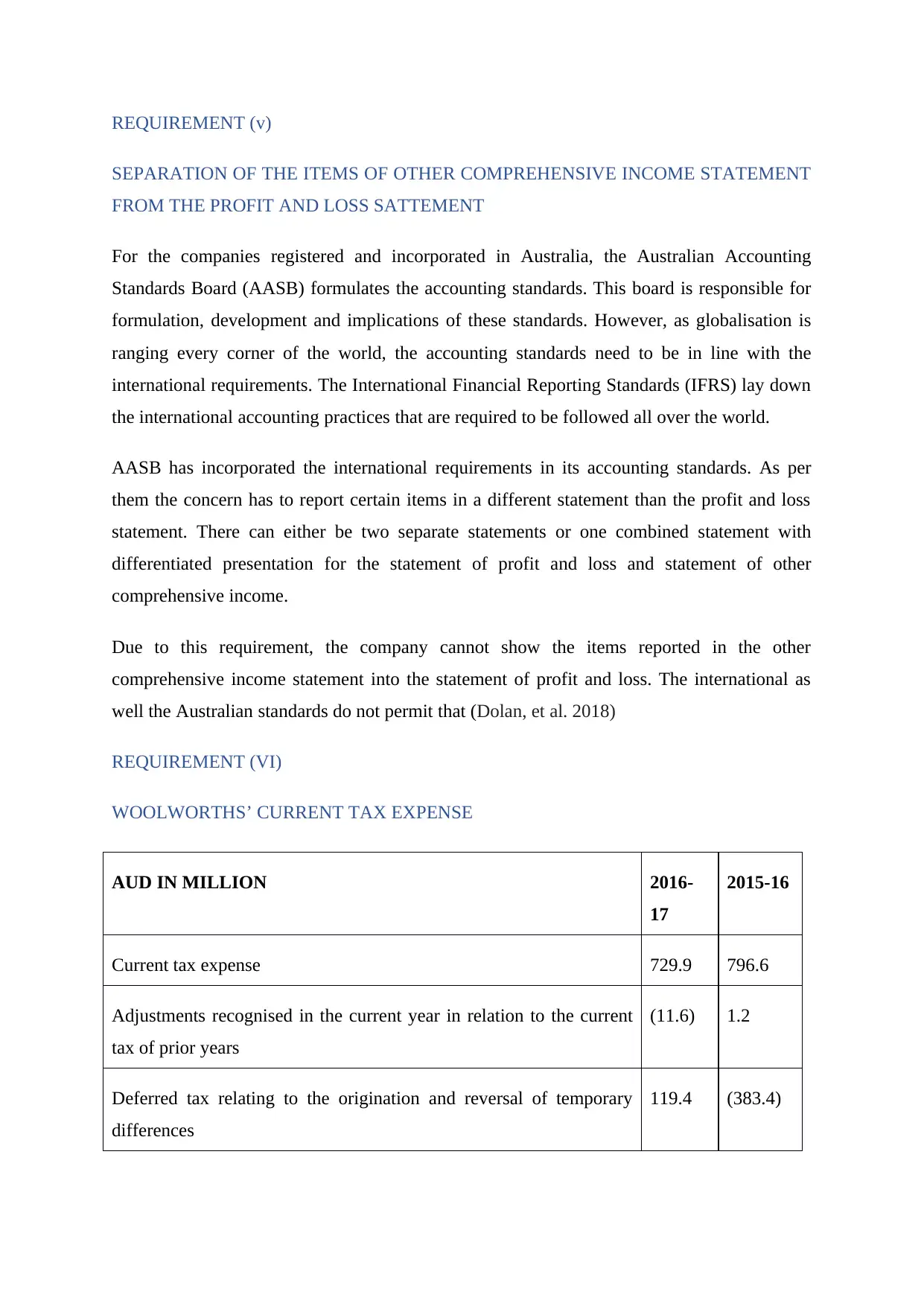
REQUIREMENT (v)
SEPARATION OF THE ITEMS OF OTHER COMPREHENSIVE INCOME STATEMENT
FROM THE PROFIT AND LOSS SATTEMENT
For the companies registered and incorporated in Australia, the Australian Accounting
Standards Board (AASB) formulates the accounting standards. This board is responsible for
formulation, development and implications of these standards. However, as globalisation is
ranging every corner of the world, the accounting standards need to be in line with the
international requirements. The International Financial Reporting Standards (IFRS) lay down
the international accounting practices that are required to be followed all over the world.
AASB has incorporated the international requirements in its accounting standards. As per
them the concern has to report certain items in a different statement than the profit and loss
statement. There can either be two separate statements or one combined statement with
differentiated presentation for the statement of profit and loss and statement of other
comprehensive income.
Due to this requirement, the company cannot show the items reported in the other
comprehensive income statement into the statement of profit and loss. The international as
well the Australian standards do not permit that (Dolan, et al. 2018)
REQUIREMENT (VI)
WOOLWORTHS’ CURRENT TAX EXPENSE
AUD IN MILLION 2016-
17
2015-16
Current tax expense 729.9 796.6
Adjustments recognised in the current year in relation to the current
tax of prior years
(11.6) 1.2
Deferred tax relating to the origination and reversal of temporary
differences
119.4 (383.4)
SEPARATION OF THE ITEMS OF OTHER COMPREHENSIVE INCOME STATEMENT
FROM THE PROFIT AND LOSS SATTEMENT
For the companies registered and incorporated in Australia, the Australian Accounting
Standards Board (AASB) formulates the accounting standards. This board is responsible for
formulation, development and implications of these standards. However, as globalisation is
ranging every corner of the world, the accounting standards need to be in line with the
international requirements. The International Financial Reporting Standards (IFRS) lay down
the international accounting practices that are required to be followed all over the world.
AASB has incorporated the international requirements in its accounting standards. As per
them the concern has to report certain items in a different statement than the profit and loss
statement. There can either be two separate statements or one combined statement with
differentiated presentation for the statement of profit and loss and statement of other
comprehensive income.
Due to this requirement, the company cannot show the items reported in the other
comprehensive income statement into the statement of profit and loss. The international as
well the Australian standards do not permit that (Dolan, et al. 2018)
REQUIREMENT (VI)
WOOLWORTHS’ CURRENT TAX EXPENSE
AUD IN MILLION 2016-
17
2015-16
Current tax expense 729.9 796.6
Adjustments recognised in the current year in relation to the current
tax of prior years
(11.6) 1.2
Deferred tax relating to the origination and reversal of temporary
differences
119.4 (383.4)
Paraphrase This Document
Need a fresh take? Get an instant paraphrase of this document with our AI Paraphraser
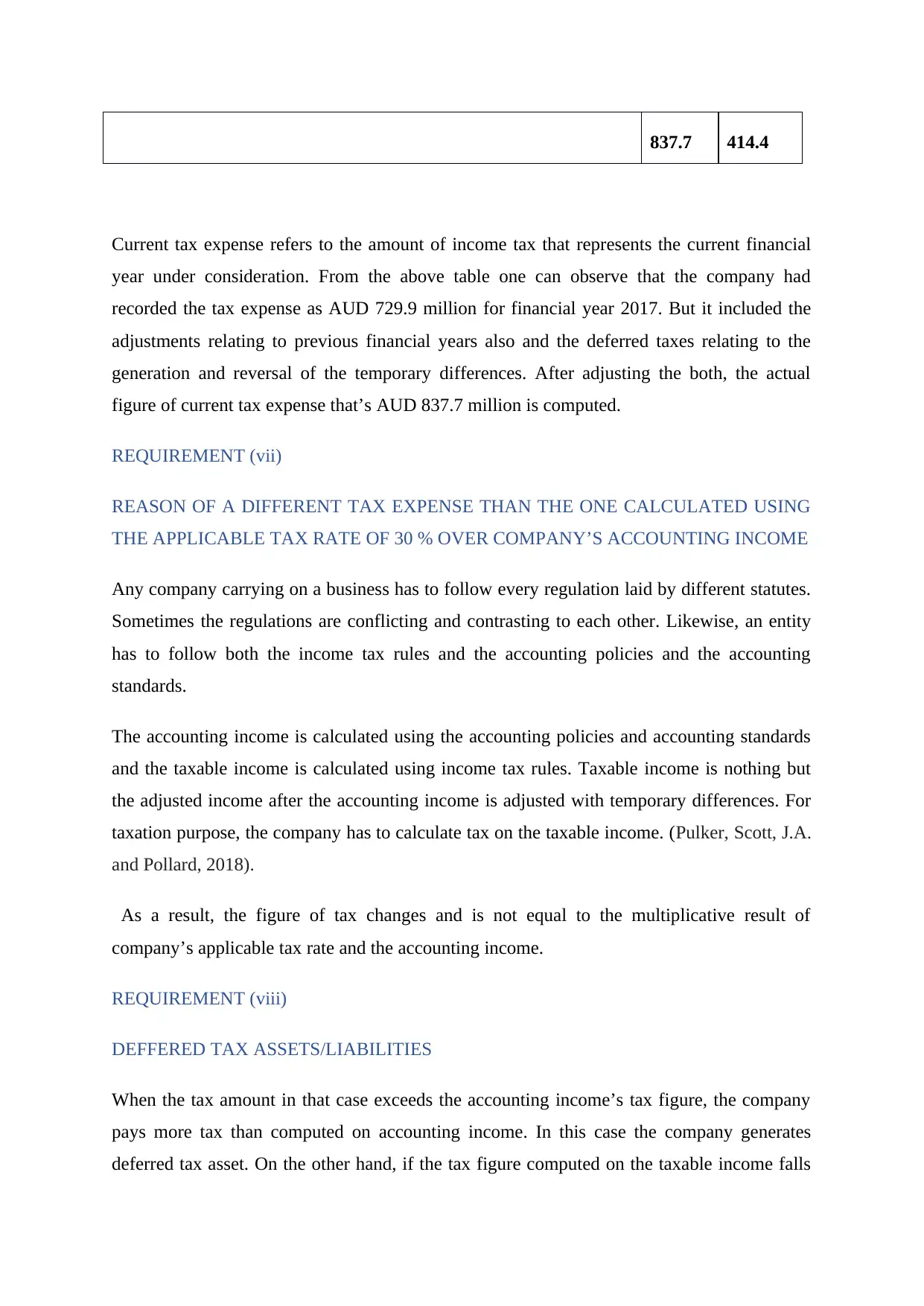
837.7 414.4
Current tax expense refers to the amount of income tax that represents the current financial
year under consideration. From the above table one can observe that the company had
recorded the tax expense as AUD 729.9 million for financial year 2017. But it included the
adjustments relating to previous financial years also and the deferred taxes relating to the
generation and reversal of the temporary differences. After adjusting the both, the actual
figure of current tax expense that’s AUD 837.7 million is computed.
REQUIREMENT (vii)
REASON OF A DIFFERENT TAX EXPENSE THAN THE ONE CALCULATED USING
THE APPLICABLE TAX RATE OF 30 % OVER COMPANY’S ACCOUNTING INCOME
Any company carrying on a business has to follow every regulation laid by different statutes.
Sometimes the regulations are conflicting and contrasting to each other. Likewise, an entity
has to follow both the income tax rules and the accounting policies and the accounting
standards.
The accounting income is calculated using the accounting policies and accounting standards
and the taxable income is calculated using income tax rules. Taxable income is nothing but
the adjusted income after the accounting income is adjusted with temporary differences. For
taxation purpose, the company has to calculate tax on the taxable income. (Pulker, Scott, J.A.
and Pollard, 2018).
As a result, the figure of tax changes and is not equal to the multiplicative result of
company’s applicable tax rate and the accounting income.
REQUIREMENT (viii)
DEFFERED TAX ASSETS/LIABILITIES
When the tax amount in that case exceeds the accounting income’s tax figure, the company
pays more tax than computed on accounting income. In this case the company generates
deferred tax asset. On the other hand, if the tax figure computed on the taxable income falls
Current tax expense refers to the amount of income tax that represents the current financial
year under consideration. From the above table one can observe that the company had
recorded the tax expense as AUD 729.9 million for financial year 2017. But it included the
adjustments relating to previous financial years also and the deferred taxes relating to the
generation and reversal of the temporary differences. After adjusting the both, the actual
figure of current tax expense that’s AUD 837.7 million is computed.
REQUIREMENT (vii)
REASON OF A DIFFERENT TAX EXPENSE THAN THE ONE CALCULATED USING
THE APPLICABLE TAX RATE OF 30 % OVER COMPANY’S ACCOUNTING INCOME
Any company carrying on a business has to follow every regulation laid by different statutes.
Sometimes the regulations are conflicting and contrasting to each other. Likewise, an entity
has to follow both the income tax rules and the accounting policies and the accounting
standards.
The accounting income is calculated using the accounting policies and accounting standards
and the taxable income is calculated using income tax rules. Taxable income is nothing but
the adjusted income after the accounting income is adjusted with temporary differences. For
taxation purpose, the company has to calculate tax on the taxable income. (Pulker, Scott, J.A.
and Pollard, 2018).
As a result, the figure of tax changes and is not equal to the multiplicative result of
company’s applicable tax rate and the accounting income.
REQUIREMENT (viii)
DEFFERED TAX ASSETS/LIABILITIES
When the tax amount in that case exceeds the accounting income’s tax figure, the company
pays more tax than computed on accounting income. In this case the company generates
deferred tax asset. On the other hand, if the tax figure computed on the taxable income falls
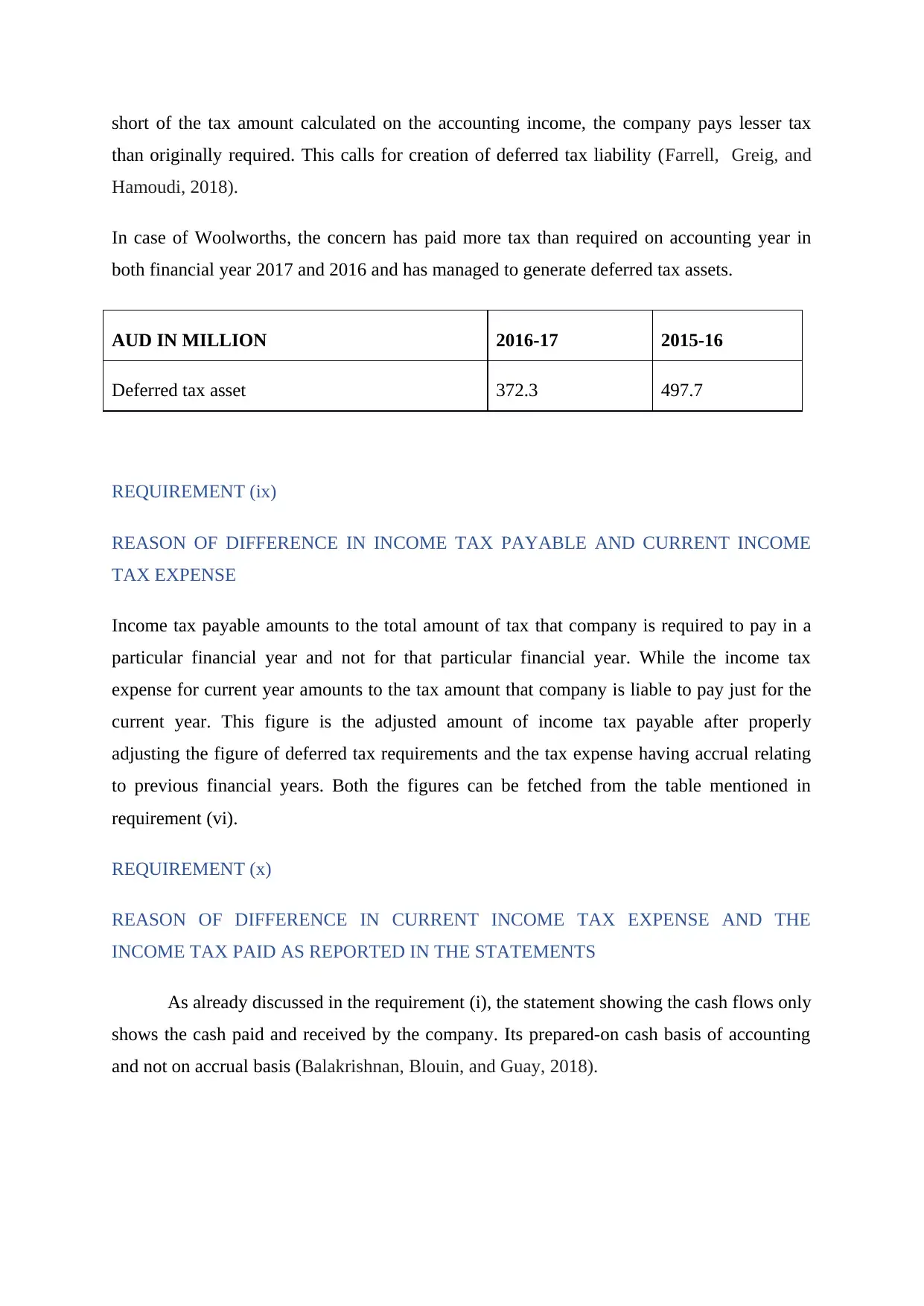
short of the tax amount calculated on the accounting income, the company pays lesser tax
than originally required. This calls for creation of deferred tax liability (Farrell, Greig, and
Hamoudi, 2018).
In case of Woolworths, the concern has paid more tax than required on accounting year in
both financial year 2017 and 2016 and has managed to generate deferred tax assets.
AUD IN MILLION 2016-17 2015-16
Deferred tax asset 372.3 497.7
REQUIREMENT (ix)
REASON OF DIFFERENCE IN INCOME TAX PAYABLE AND CURRENT INCOME
TAX EXPENSE
Income tax payable amounts to the total amount of tax that company is required to pay in a
particular financial year and not for that particular financial year. While the income tax
expense for current year amounts to the tax amount that company is liable to pay just for the
current year. This figure is the adjusted amount of income tax payable after properly
adjusting the figure of deferred tax requirements and the tax expense having accrual relating
to previous financial years. Both the figures can be fetched from the table mentioned in
requirement (vi).
REQUIREMENT (x)
REASON OF DIFFERENCE IN CURRENT INCOME TAX EXPENSE AND THE
INCOME TAX PAID AS REPORTED IN THE STATEMENTS
As already discussed in the requirement (i), the statement showing the cash flows only
shows the cash paid and received by the company. Its prepared-on cash basis of accounting
and not on accrual basis (Balakrishnan, Blouin, and Guay, 2018).
than originally required. This calls for creation of deferred tax liability (Farrell, Greig, and
Hamoudi, 2018).
In case of Woolworths, the concern has paid more tax than required on accounting year in
both financial year 2017 and 2016 and has managed to generate deferred tax assets.
AUD IN MILLION 2016-17 2015-16
Deferred tax asset 372.3 497.7
REQUIREMENT (ix)
REASON OF DIFFERENCE IN INCOME TAX PAYABLE AND CURRENT INCOME
TAX EXPENSE
Income tax payable amounts to the total amount of tax that company is required to pay in a
particular financial year and not for that particular financial year. While the income tax
expense for current year amounts to the tax amount that company is liable to pay just for the
current year. This figure is the adjusted amount of income tax payable after properly
adjusting the figure of deferred tax requirements and the tax expense having accrual relating
to previous financial years. Both the figures can be fetched from the table mentioned in
requirement (vi).
REQUIREMENT (x)
REASON OF DIFFERENCE IN CURRENT INCOME TAX EXPENSE AND THE
INCOME TAX PAID AS REPORTED IN THE STATEMENTS
As already discussed in the requirement (i), the statement showing the cash flows only
shows the cash paid and received by the company. Its prepared-on cash basis of accounting
and not on accrual basis (Balakrishnan, Blouin, and Guay, 2018).
⊘ This is a preview!⊘
Do you want full access?
Subscribe today to unlock all pages.

Trusted by 1+ million students worldwide

REQUIREMENT (xi)
The most interesting, confusing and difficult thing about Woolworths is
coincidentally same. It’s the way the annual report is detailed with the different and informed
statements. Along with providing the public with useful information, they lead to confuse
them with over data and that makes it difficult for the users to interpret and use the same
judicially (Genser, and Holzmann2018).
Conclusion
In the current report, Woolworth’s group, an Australian retail giant is taken under
consideration to study the same. Woolworths has its operations ruled in New Zealand and
Australia with immense operations. It could be inferred that company has complied with the
all the reporting and legal rules and laws given under the AASB 112.
The most interesting, confusing and difficult thing about Woolworths is
coincidentally same. It’s the way the annual report is detailed with the different and informed
statements. Along with providing the public with useful information, they lead to confuse
them with over data and that makes it difficult for the users to interpret and use the same
judicially (Genser, and Holzmann2018).
Conclusion
In the current report, Woolworth’s group, an Australian retail giant is taken under
consideration to study the same. Woolworths has its operations ruled in New Zealand and
Australia with immense operations. It could be inferred that company has complied with the
all the reporting and legal rules and laws given under the AASB 112.
Paraphrase This Document
Need a fresh take? Get an instant paraphrase of this document with our AI Paraphraser
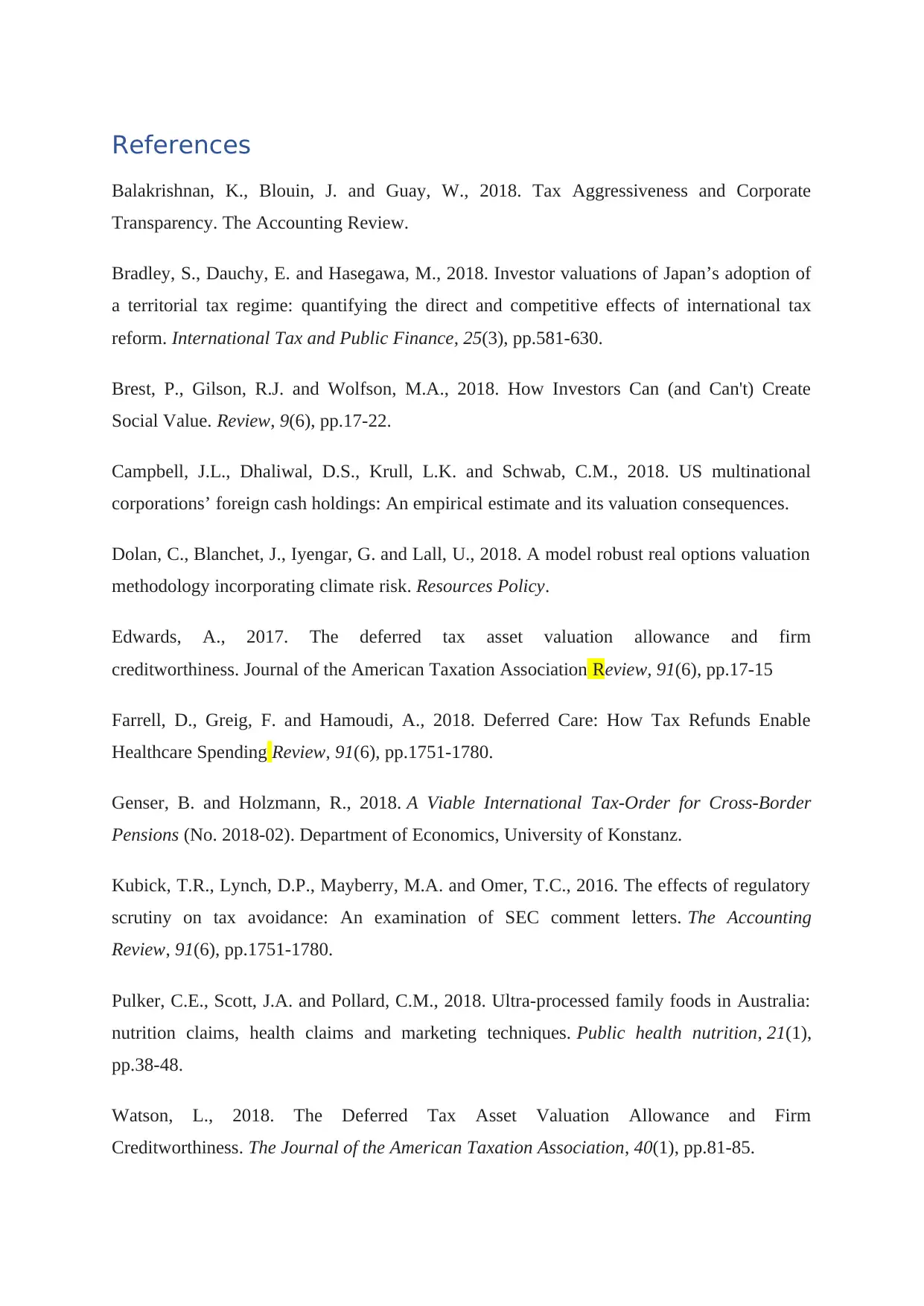
References
Balakrishnan, K., Blouin, J. and Guay, W., 2018. Tax Aggressiveness and Corporate
Transparency. The Accounting Review.
Bradley, S., Dauchy, E. and Hasegawa, M., 2018. Investor valuations of Japan’s adoption of
a territorial tax regime: quantifying the direct and competitive effects of international tax
reform. International Tax and Public Finance, 25(3), pp.581-630.
Brest, P., Gilson, R.J. and Wolfson, M.A., 2018. How Investors Can (and Can't) Create
Social Value. Review, 9(6), pp.17-22.
Campbell, J.L., Dhaliwal, D.S., Krull, L.K. and Schwab, C.M., 2018. US multinational
corporations’ foreign cash holdings: An empirical estimate and its valuation consequences.
Dolan, C., Blanchet, J., Iyengar, G. and Lall, U., 2018. A model robust real options valuation
methodology incorporating climate risk. Resources Policy.
Edwards, A., 2017. The deferred tax asset valuation allowance and firm
creditworthiness. Journal of the American Taxation Association Review, 91(6), pp.17-15
Farrell, D., Greig, F. and Hamoudi, A., 2018. Deferred Care: How Tax Refunds Enable
Healthcare Spending Review, 91(6), pp.1751-1780.
Genser, B. and Holzmann, R., 2018. A Viable International Tax-Order for Cross-Border
Pensions (No. 2018-02). Department of Economics, University of Konstanz.
Kubick, T.R., Lynch, D.P., Mayberry, M.A. and Omer, T.C., 2016. The effects of regulatory
scrutiny on tax avoidance: An examination of SEC comment letters. The Accounting
Review, 91(6), pp.1751-1780.
Pulker, C.E., Scott, J.A. and Pollard, C.M., 2018. Ultra-processed family foods in Australia:
nutrition claims, health claims and marketing techniques. Public health nutrition, 21(1),
pp.38-48.
Watson, L., 2018. The Deferred Tax Asset Valuation Allowance and Firm
Creditworthiness. The Journal of the American Taxation Association, 40(1), pp.81-85.
Balakrishnan, K., Blouin, J. and Guay, W., 2018. Tax Aggressiveness and Corporate
Transparency. The Accounting Review.
Bradley, S., Dauchy, E. and Hasegawa, M., 2018. Investor valuations of Japan’s adoption of
a territorial tax regime: quantifying the direct and competitive effects of international tax
reform. International Tax and Public Finance, 25(3), pp.581-630.
Brest, P., Gilson, R.J. and Wolfson, M.A., 2018. How Investors Can (and Can't) Create
Social Value. Review, 9(6), pp.17-22.
Campbell, J.L., Dhaliwal, D.S., Krull, L.K. and Schwab, C.M., 2018. US multinational
corporations’ foreign cash holdings: An empirical estimate and its valuation consequences.
Dolan, C., Blanchet, J., Iyengar, G. and Lall, U., 2018. A model robust real options valuation
methodology incorporating climate risk. Resources Policy.
Edwards, A., 2017. The deferred tax asset valuation allowance and firm
creditworthiness. Journal of the American Taxation Association Review, 91(6), pp.17-15
Farrell, D., Greig, F. and Hamoudi, A., 2018. Deferred Care: How Tax Refunds Enable
Healthcare Spending Review, 91(6), pp.1751-1780.
Genser, B. and Holzmann, R., 2018. A Viable International Tax-Order for Cross-Border
Pensions (No. 2018-02). Department of Economics, University of Konstanz.
Kubick, T.R., Lynch, D.P., Mayberry, M.A. and Omer, T.C., 2016. The effects of regulatory
scrutiny on tax avoidance: An examination of SEC comment letters. The Accounting
Review, 91(6), pp.1751-1780.
Pulker, C.E., Scott, J.A. and Pollard, C.M., 2018. Ultra-processed family foods in Australia:
nutrition claims, health claims and marketing techniques. Public health nutrition, 21(1),
pp.38-48.
Watson, L., 2018. The Deferred Tax Asset Valuation Allowance and Firm
Creditworthiness. The Journal of the American Taxation Association, 40(1), pp.81-85.
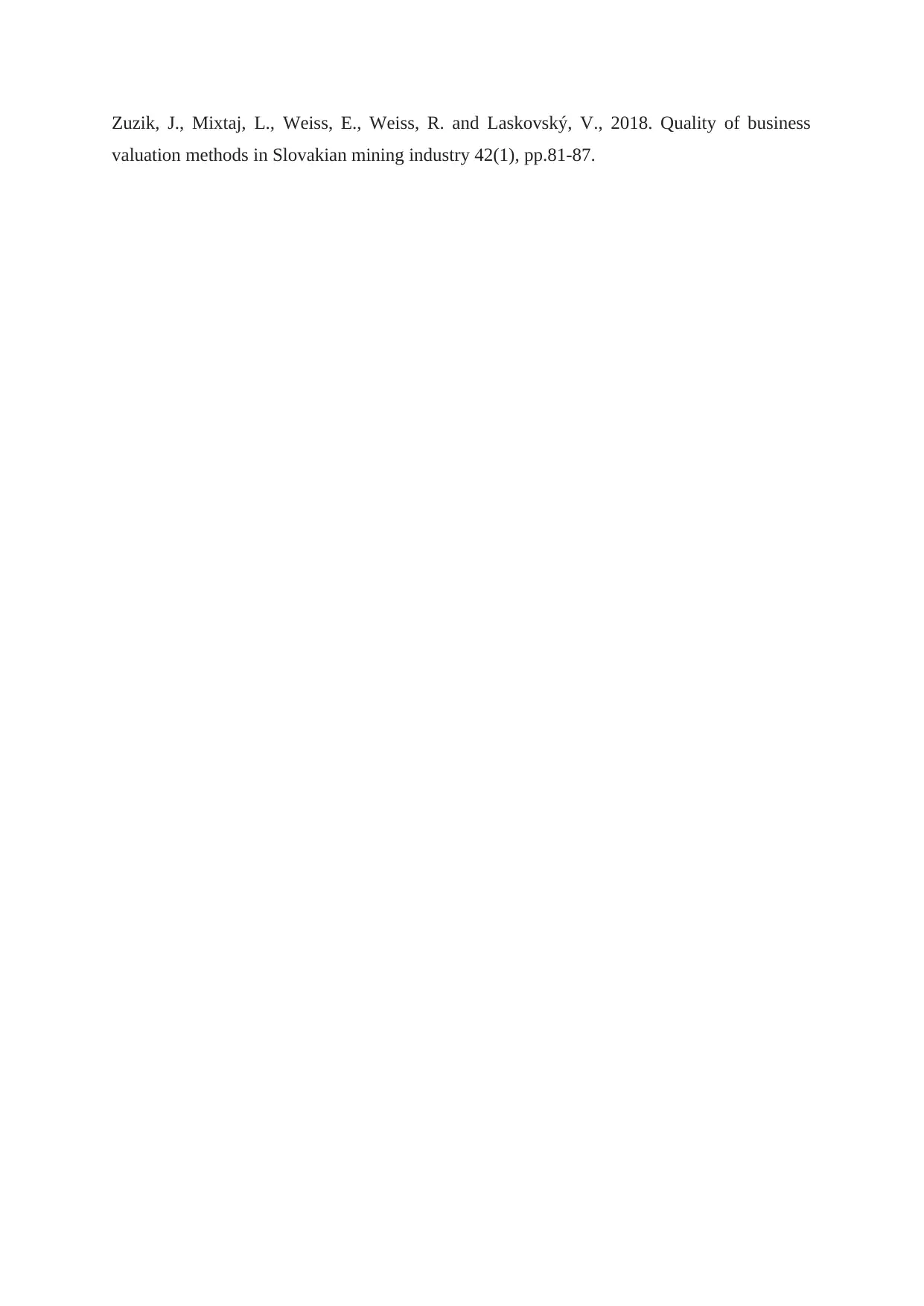
Zuzik, J., Mixtaj, L., Weiss, E., Weiss, R. and Laskovský, V., 2018. Quality of business
valuation methods in Slovakian mining industry 42(1), pp.81-87.
valuation methods in Slovakian mining industry 42(1), pp.81-87.
⊘ This is a preview!⊘
Do you want full access?
Subscribe today to unlock all pages.

Trusted by 1+ million students worldwide
1 out of 12
Related Documents
Your All-in-One AI-Powered Toolkit for Academic Success.
+13062052269
info@desklib.com
Available 24*7 on WhatsApp / Email
![[object Object]](/_next/static/media/star-bottom.7253800d.svg)
Unlock your academic potential
Copyright © 2020–2025 A2Z Services. All Rights Reserved. Developed and managed by ZUCOL.



